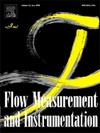Temperature drift characteristics and compensation study of double-winding thermal mass flow meter
IF 2.3
3区 工程技术
Q2 ENGINEERING, MECHANICAL
引用次数: 0
Abstract
Thermal mass flow meters are broadly used in different parts of industry for flow metering objectives. One of the most widely used thermal flow meters is capillary tube type. Aiming at the traditional thermal flow sensor, which has the problems of low flow measurement accuracy and temperature drift, based on the principle of fluid flow and heat transfer, a double-winding distributed thermal flow sensor with constant temperature operation is developed. The thermal flow measurement principle is studied and the sensor temperature field is simulated by COMSOL software. The effect of ambient temperature on the measurement results under different structural parameters and operating parameters is investigated by simulation. The optimal sensor operating parameters are determined, and the sensor temperature adaptability is improved. In addition, under the condition of structural error, the influence of structural error on the measurement is analyzed. Simulation calculations are carried out at different ambient temperatures to obtain the corrected relationship between the measured value and the ambient temperature. Finally, according to the simulation results, the sensor is designed and processed, and tested by the standard flow output device. The temperature correction algorithm is obtained according to the experimental results. And the effectiveness of this temperature correction algorithm is verified under different ambient temperatures and different flow inputs. The experiments show that through this correction algorithm, the test error of the sensor has been significantly reduced in the range of the sensor, and the temperature adaptability of the sensor has been improved.
双绕组热质量流量计的温度漂移特性及补偿研究
热质量流量计广泛应用于各行业的流量计量目标。应用最广泛的热流量计之一是毛细管式热流量计。针对传统热流传感器存在流量测量精度低、温度漂移等问题,基于流体流动和传热原理,研制了一种双绕组分布式恒温工作热流传感器。研究了热流测量原理,利用COMSOL软件对传感器温度场进行了仿真。通过仿真研究了不同结构参数和工作参数下环境温度对测量结果的影响。确定了传感器的最佳工作参数,提高了传感器的温度适应性。此外,在存在结构误差的情况下,分析了结构误差对测量的影响。在不同的环境温度下进行了模拟计算,得到了测量值与环境温度之间的修正关系。最后,根据仿真结果对传感器进行了设计和加工,并在标准流量输出装置上进行了测试。根据实验结果,给出了温度校正算法。并在不同的环境温度和不同的流量输入下验证了该温度校正算法的有效性。实验表明,通过该校正算法,传感器的测试误差在传感器范围内得到了明显的减小,传感器的温度自适应能力得到了提高。
本文章由计算机程序翻译,如有差异,请以英文原文为准。
求助全文
约1分钟内获得全文
求助全文
来源期刊

Flow Measurement and Instrumentation
工程技术-工程:机械
CiteScore
4.30
自引率
13.60%
发文量
123
审稿时长
6 months
期刊介绍:
Flow Measurement and Instrumentation is dedicated to disseminating the latest research results on all aspects of flow measurement, in both closed conduits and open channels. The design of flow measurement systems involves a wide variety of multidisciplinary activities including modelling the flow sensor, the fluid flow and the sensor/fluid interactions through the use of computation techniques; the development of advanced transducer systems and their associated signal processing and the laboratory and field assessment of the overall system under ideal and disturbed conditions.
FMI is the essential forum for critical information exchange, and contributions are particularly encouraged in the following areas of interest:
Modelling: the application of mathematical and computational modelling to the interaction of fluid dynamics with flowmeters, including flowmeter behaviour, improved flowmeter design and installation problems. Application of CAD/CAE techniques to flowmeter modelling are eligible.
Design and development: the detailed design of the flowmeter head and/or signal processing aspects of novel flowmeters. Emphasis is given to papers identifying new sensor configurations, multisensor flow measurement systems, non-intrusive flow metering techniques and the application of microelectronic techniques in smart or intelligent systems.
Calibration techniques: including descriptions of new or existing calibration facilities and techniques, calibration data from different flowmeter types, and calibration intercomparison data from different laboratories.
Installation effect data: dealing with the effects of non-ideal flow conditions on flowmeters. Papers combining a theoretical understanding of flowmeter behaviour with experimental work are particularly welcome.
 求助内容:
求助内容: 应助结果提醒方式:
应助结果提醒方式:


